

The Galilean Satellites
Jupiter has 16 satellites or moons (we use the term "moon" to describe
spherical satellites while "satellite" may apply to an irregularly-shaped
body). All but four are small and irregular, and most of those were discovered
by telescope from Earth, but Voyager found three. We generally consider the
four large ones, known as the Galilean Moons, in honor of the Italian scientist,
Galileo, as the most extraordinary, as a group, in the solar system. We introduce
these now in the Voyager montage below, created from individual global (full)
views scaled, so that each retains its size, relative to the others:
Data gathered both by the Voyager and Galileo spacecraft on the densities and nature of the crusts of these four Moons have permitted general models of the interior of each. Io (upper left), Europa (upper right), Ganymede (lower left) all have cores; Callisto may have a small core but its interior is thought to be mainly water ice plus rock (largely undifferentiated).
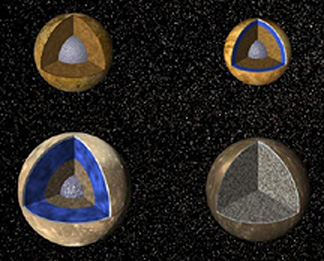
The innermost moon, Io, lies some 422,000 km (262,231 mi) from Jupiter's center. It's about 3,630 km (2256 mi) in diameter, making it just slightly larger than Earth's Moon. Different parts of Io are portrayed in these three views taken by the Galileo TV camera:

Different parts of Io are portrayed in these three views taken by the Galileo TV camera:
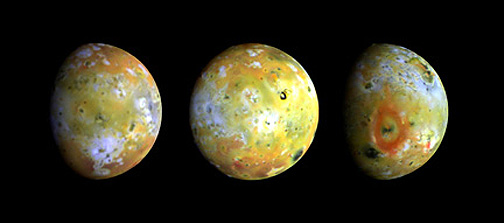
19-54:
Io displays prominent orange colors, with blackish mottled areas (that has reminded some of a giant pizza with olives). It may well be the most remarkable of all satellites, in that the surface is undergoing constant dynamic change, largely through volcanic processes. Astrogeologists have rated Io as the "most geologically active planetary body in the Solar System". What they mean is that it is undergoing more volcanic eruptions, for its size, of any such body (at least 16 volcanoes that are active have been detected); besides Earth, it is the only other object with live volcanoes spewing hot lavas. Although the ionian surface generally has a temperature of -140° C, hot spots with temperatures up to 1200° C attest to volcanically active areas. Io's surface is geologically young (no impact craters have been found on it), constantly undergoing "resurfacing" by volcanic processes.
One Voyager 1 image startled JPL scientists, because it captured a major plume from the eruption of an Ionian volcano that was then tossing material up to 300 km (186 mi) above its surface.
Other eruptions were "caught in the act" during the fly-bys meaning that, along with signs of young surface deposits, for its size Io is more volcanically active than Earth. A major eruption in progress at a volcano named Prometheus was captured by the Galileo TV camera, as depicted in these two views:
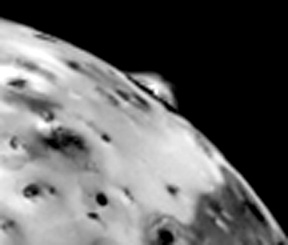
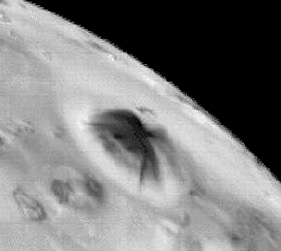
19-55:
By comparing images of Prometheus acquired by Voyager in 1979 (left) and Galileo in 1997 (right), several distinguishable major changes are evident:
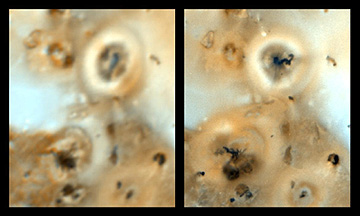
Another volcano, the caldera Pele, was imaged after it had discharged sulphurous lava, ash and gases out several hundred kilometers in all directions, forming a heart-shaped halo deposit (SO2 frost), named the Matuike Patera (volcanic field).
We've identified scores of eruption sites, but many may be inactive. At least 30 appeared to undergo one or more events during the observation periods. Volcanic deposits dominate the entire Ionian surface, some being flows and others, probably fragmental. We can trace many of these to calderas. This is a Galileo view of a typical part of the ionian surface:
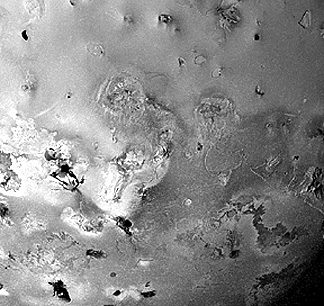
Volcanic sites can undergo significant modifications in just a few years, as demonstrated by this series of images taken over the last 18 years from Voyager 1 (upper right) through Galileo (lower right) around the volcanic complex known as Ra Patera (upper left):
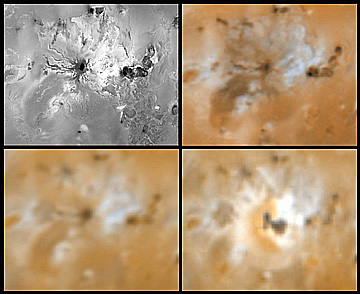
19-56:
None of the ionian volcanoes appear to be high stratocones such as are displayed as the majestic volcanic peaks observed in the Ring of Fire on Earth. Where some relief is evident, the Ionian volcanoes are more like terrestrial shield volcanoes, many with wide calderas. Haemus Mons is an example:
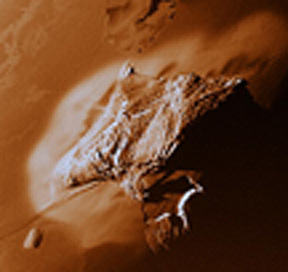
Credit: C. Hamilton
The volcanic materials are likely silicates, mixed with large amounts of (native?) sulphur and sulphur compounds. These compounds can account for Io's orange, yellow, and black colors that are typical of this element. Sulphur-rich lakes have been observed. Sulphur dioxide makes up a tenuous atmosphere.
The cause of this (totally unexpected) activity on Io is a process termed "tidal pumping," in which the outer part of this satellite flexes and stretches as much as 100 m (328 ft) as Jupiter and the other moons tug on it. The tidal energies acting on Io induce heating, and the stretching causes it to wobble.
Recently, Galileo has sent back evidence that there is an iron core whose radius is about half that (~900 km) of the complete satellite. It may be generating a small magnetic field that interacts with the intense field caused by Jupiter. Io may also have an ionosphere. It is surrounded by a vapor cloud made up of hydrogen, sodium, potassium, and ionized sulfur (derived by sputtering off the ionian surface) which has been stretched out to form a torus around its parent planet. A flux tube between Io and Jupiter allows a current of 10 million amps. to flow.
Our next moon is Europa (diameter = 3,140 km (1951 mi), 671,000 km (416959 mi) from Jupiter. Below are images, as it appears from Galileo:
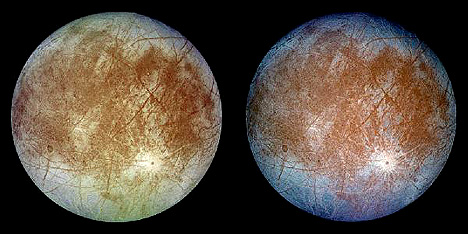
It reminds some viewers of a giant "cue ball" that has cracked with age. The left view is a natural color image. On the right is a false color image, made by projecting the violet band through blue, the green band through green, and the IR through red.
19-57:
Seen by Voyager close up, the surface is extremely smooth, with few markings (minimal
craters) other than the pronounced sets of darker brown "fractures" that divide the crust into polygonal segments. These cracks are only slightly higher or lower (<300 m [984 ft]) than the main surface that appears to be water ice, which may top an ice-water slush or a pure water "ocean" at some depth before grading again into ice and then rocky material. Next is a view of this surface from Galileo.

At this higher resolution, we can see several orders (size discontinuities) of fracturing. Some are distinctly curvilinear (a common pattern in rapidly cooled liquids, such as those used to make silicate glass). Slivers of dark material are scattered within. On Europa,

some interior rocky material may mix with the ice. The origin of these linear breaks is uncertain. Scientists compare these breaks with polar sea ice on Earth, which experience cracks or "leads" by tension, as water currents cause them to flex. These cracks then reheal. Ridges, formed by compression, are an alternative.
19-58:
Galileo shed more light on this, when it made a close approach (586 km [364 miles]),on February 20, 1997. The picture on the top shows closely-spaced parallel cracks in blocks, with different orientations, separated by a high ridge, furrowed in its center. On the bottom are "ice rafts" rising above surrounding ice.
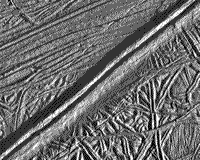

These appear to be break-ups of a thin ice cover (with its leads), in which the rafts are free to move about, with additional evidence favoring a liquid water body below. The implication of an "ocean" with a frozen crust has led some scientists to speculate that conditions may be favorable for primitive life in this liquid. This supposition has fueled intense interest in getting even closer approaches to Europa, which planners scheduled in the continuing Galileo observations. Officials are considering a new mission in the next century, specifically to search for more signs of life.
More recent observations shed further light on the variety of terrains on Europa. The scene below, covering an area of 7 km by 4 km (4.3 mi x 2.5 mi), shows a chaos of small plates and wedges in an area known as Conamara Chaos. This December 16, 1997, image reveals chunks of ice, perhaps bound to each other by a matrix of ice mush, including several hillocks rising to 250 m (820 ft). Note the single flat lineated plate at the top. On the left is a straight chasm that is nearly 400 m (1312 ft) across.
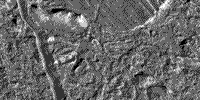
Recently, Europa investigators have proposed the possibility of "ice volcanoes" in which viscous ice (perhaps with some water) erupts from vents and flows like a glacier over the surface. Galileo has imaged such flows, as seen in this image in which a flow (in the center) is extending over large cracks.
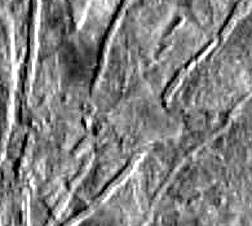

Primary Author: Nicholas M.
Short, Sr. email: nmshort@epix.net
Contributor Information
Last Updated: September '99
Site Curator: Nannette Fekete